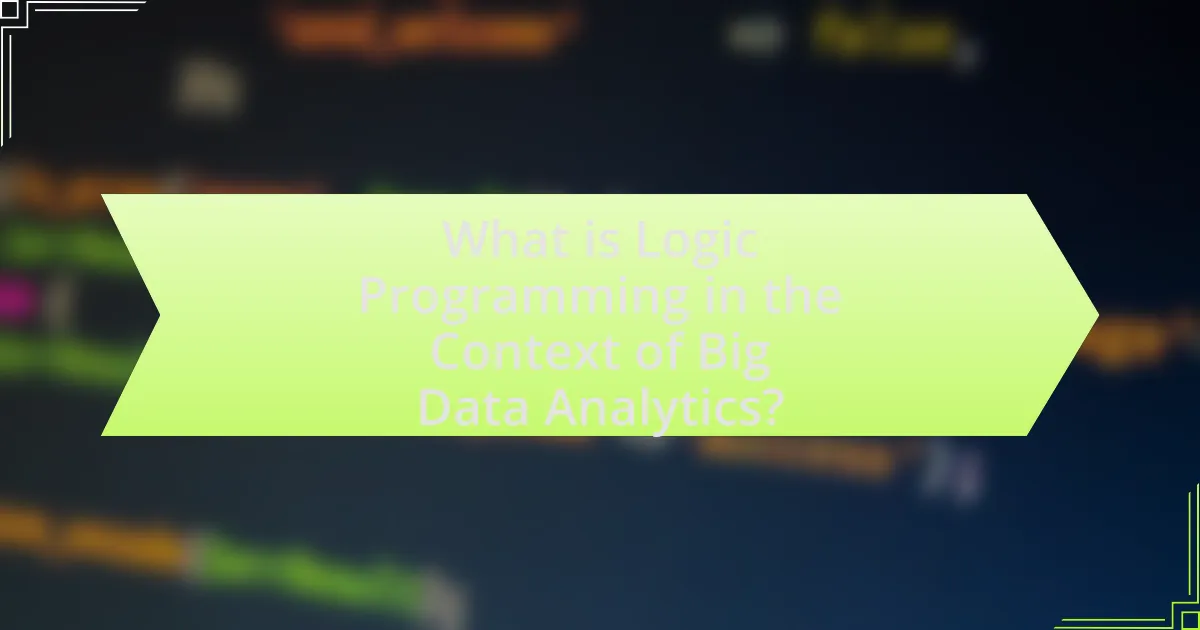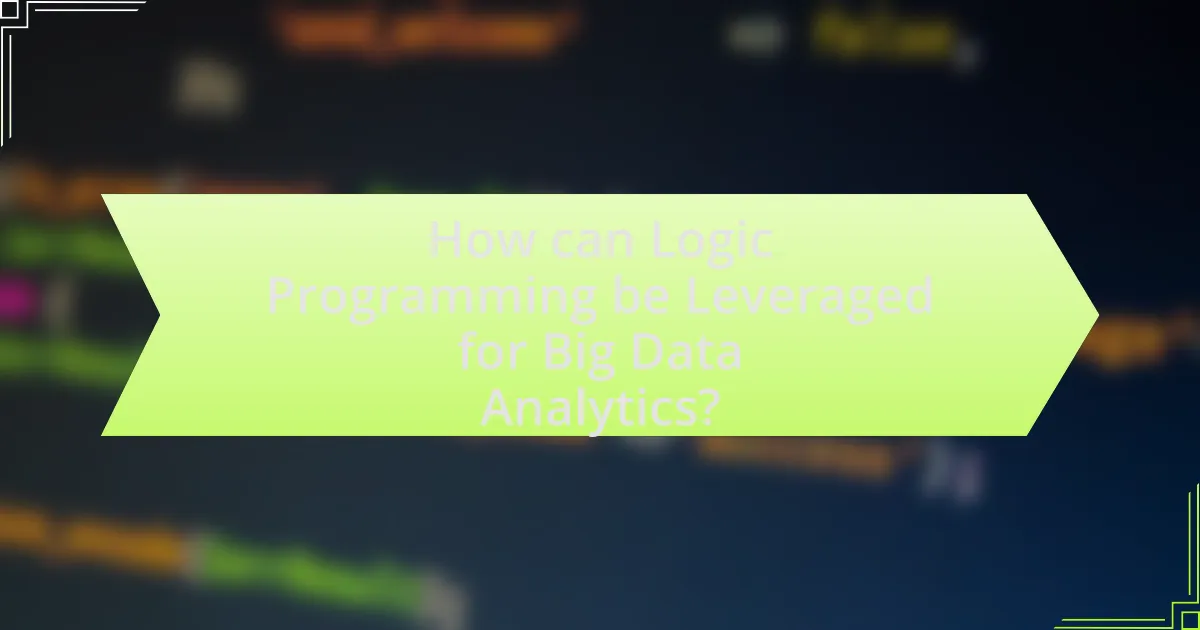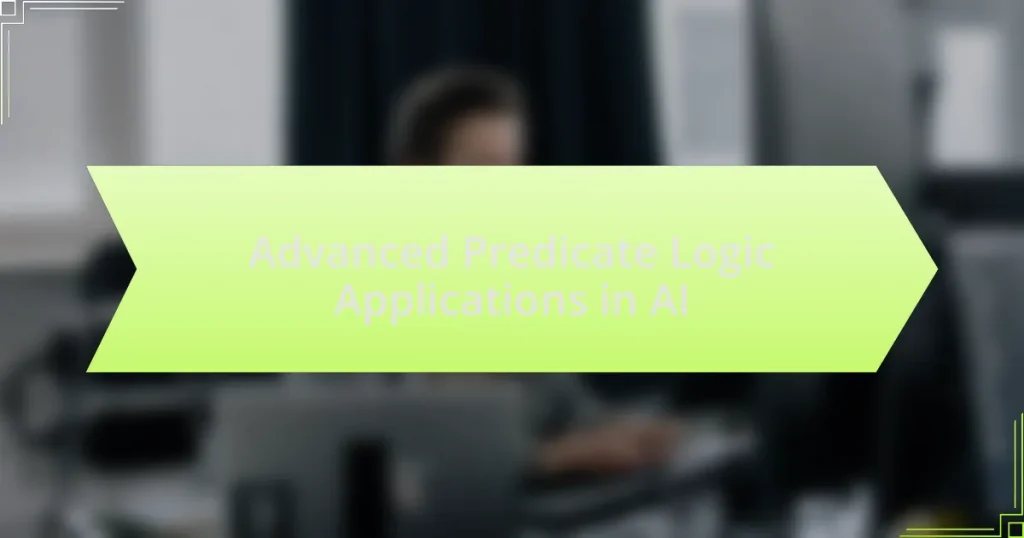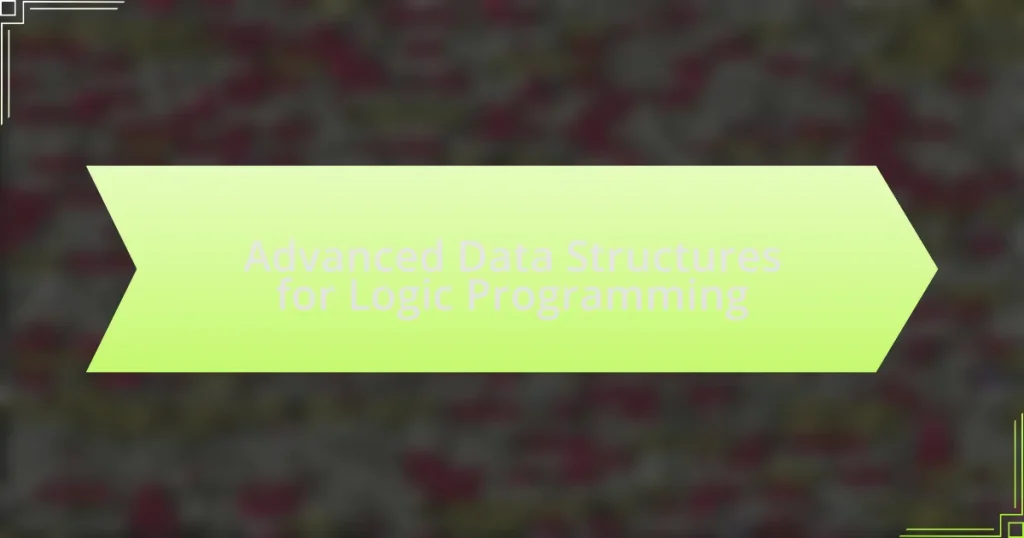Logic programming is a programming paradigm that utilizes formal logic to express computations, particularly in the realm of big data analytics. This article explores how logic programming facilitates the representation and manipulation of complex data relationships, enabling efficient querying and reasoning over large datasets. It highlights the differences between logic programming and other paradigms, outlines its fundamental principles, and discusses its advantages and challenges in big data contexts. Additionally, the article examines tools and frameworks that support logic programming, best practices for implementation, and strategies to optimize performance, ultimately providing insights into leveraging logic programming for enhanced data analysis and decision-making in big data environments.

What is Logic Programming in the Context of Big Data Analytics?
Logic programming is a programming paradigm that uses formal logic to express computations, and in the context of big data analytics, it facilitates the representation and manipulation of complex data relationships. This approach allows for declarative problem-solving, where users specify what the outcome should be rather than detailing the steps to achieve it, making it particularly effective for querying large datasets. For instance, languages like Prolog enable the formulation of queries that can infer relationships and patterns from vast amounts of data, enhancing the ability to derive insights from big data. The effectiveness of logic programming in big data analytics is supported by its ability to handle uncertainty and incomplete information, which are common in large datasets, thus providing a robust framework for data analysis.
How does Logic Programming differ from other programming paradigms?
Logic programming differs from other programming paradigms primarily in its approach to problem-solving, which is based on formal logic rather than procedural or object-oriented methods. In logic programming, programs consist of a set of facts and rules that define relationships and constraints, allowing the system to infer conclusions through a process called resolution. This contrasts with imperative programming, where the focus is on explicitly defining a sequence of commands to achieve a desired outcome, and with object-oriented programming, which emphasizes data encapsulation and interaction through objects. The declarative nature of logic programming enables it to express complex queries succinctly, making it particularly effective for applications in artificial intelligence and big data analytics, where reasoning and pattern recognition are crucial.
What are the fundamental principles of Logic Programming?
The fundamental principles of Logic Programming include the use of formal logic to express programs, the notion of facts and rules to represent knowledge, and the process of inference to derive conclusions from these facts and rules. Logic Programming is based on the idea that computation can be viewed as a form of logical deduction, where a program consists of a set of logical statements that define relationships and constraints. This approach allows for declarative programming, where the focus is on what the program should accomplish rather than how to achieve it. The validity of these principles is supported by the success of languages like Prolog, which utilize these concepts to solve complex problems in artificial intelligence and data analysis.
How does Logic Programming facilitate reasoning about data?
Logic programming facilitates reasoning about data by allowing the representation of knowledge in a formal, declarative manner that enables automated inference. This approach uses rules and facts to derive conclusions, making it easier to query complex datasets and uncover relationships. For instance, Prolog, a prominent logic programming language, allows users to define relationships and rules that can be processed to answer queries efficiently. This capability is particularly beneficial in big data analytics, where traditional procedural programming may struggle to manage the complexity and volume of data. The ability to express logical relationships succinctly and derive new information through inference engines enhances the analytical power of logic programming in data reasoning tasks.
What role does Logic Programming play in Big Data Analytics?
Logic Programming plays a crucial role in Big Data Analytics by enabling efficient data querying and reasoning through its declarative nature. This programming paradigm allows for the expression of complex relationships and rules, facilitating the extraction of insights from large datasets. For instance, Prolog, a prominent logic programming language, is utilized in various data mining applications to infer patterns and relationships, enhancing decision-making processes. The ability to represent knowledge in a structured format allows analysts to perform sophisticated queries that traditional programming methods may struggle with, thereby improving the overall effectiveness of data analysis.
How can Logic Programming enhance data processing capabilities?
Logic programming enhances data processing capabilities by enabling declarative problem-solving, which allows users to specify what the desired outcome is rather than how to achieve it. This approach simplifies complex data queries and manipulations, making it easier to derive insights from large datasets. For instance, Prolog, a prominent logic programming language, facilitates efficient handling of relationships and rules, which can be particularly beneficial in scenarios involving intricate data structures or dependencies. Studies have shown that logic programming can significantly reduce the time required for data retrieval and processing, as it optimizes the execution of queries through logical inference mechanisms.
What are the advantages of using Logic Programming for data analysis?
Logic Programming offers several advantages for data analysis, including declarative problem-solving, efficient handling of complex queries, and enhanced reasoning capabilities. Declarative problem-solving allows users to specify what they want to achieve without detailing how to achieve it, simplifying the analysis process. Efficient handling of complex queries is facilitated by the ability to express relationships and constraints clearly, enabling faster retrieval of relevant data. Enhanced reasoning capabilities stem from the logical inference mechanisms inherent in Logic Programming, which can derive new information from existing data, making it particularly useful for tasks such as knowledge discovery and pattern recognition. These advantages contribute to more effective and streamlined data analysis processes.

How can Logic Programming be Leveraged for Big Data Analytics?
Logic programming can be leveraged for big data analytics by enabling efficient querying and reasoning over large datasets. This approach utilizes logical constructs to express complex relationships and rules, allowing for more intuitive data manipulation and analysis. For instance, Prolog, a prominent logic programming language, facilitates the development of algorithms that can infer new information from existing data, which is particularly useful in scenarios involving unstructured or semi-structured data. Additionally, logic programming supports declarative programming paradigms, making it easier to specify what data to retrieve without detailing how to obtain it, thus enhancing productivity in big data environments. The ability to handle uncertainty and incomplete information through probabilistic logic further strengthens its applicability in big data analytics, as evidenced by its use in various domains such as healthcare and finance for predictive modeling and decision-making.
What tools and frameworks support Logic Programming in Big Data?
Tools and frameworks that support Logic Programming in Big Data include Prolog, Apache Jena, and Datalog. Prolog is a well-established logic programming language that facilitates complex queries and reasoning over large datasets. Apache Jena is a Java framework for building Semantic Web and Linked Data applications, enabling logic-based reasoning over RDF data. Datalog, a declarative logic programming language, is often used in database systems for querying and reasoning about data, particularly in big data contexts. These tools are validated by their widespread use in academic and industrial applications, demonstrating their effectiveness in handling large-scale data analytics through logic programming principles.
Which Logic Programming languages are most effective for Big Data?
Prolog and Datalog are the most effective logic programming languages for Big Data. Prolog excels in handling complex queries and reasoning tasks, making it suitable for applications like natural language processing and knowledge representation. Datalog, on the other hand, is optimized for querying large datasets and is often used in database systems and data integration tasks. Both languages leverage logical inference, which allows for efficient data manipulation and retrieval, essential for Big Data analytics.
How do these tools integrate with existing Big Data technologies?
These tools integrate with existing Big Data technologies by utilizing standardized APIs and frameworks that facilitate seamless data exchange and processing. For instance, tools like Apache Spark and Hadoop can be enhanced with logic programming languages such as Prolog, allowing for advanced querying and reasoning capabilities on large datasets. This integration is supported by the ability of these tools to handle distributed data processing, enabling efficient execution of logic-based algorithms across clusters. Additionally, the compatibility with data formats like JSON and Parquet ensures that data can be easily ingested and processed, further solidifying the integration with existing Big Data ecosystems.
What are the best practices for implementing Logic Programming in Big Data projects?
The best practices for implementing Logic Programming in Big Data projects include ensuring scalability, optimizing query performance, and integrating with existing data processing frameworks. Scalability is crucial as Logic Programming can handle complex queries over large datasets; thus, utilizing distributed computing platforms like Apache Spark enhances performance. Optimizing query performance involves using efficient algorithms and indexing strategies to reduce execution time, which is essential in Big Data environments where latency can impact results. Additionally, integrating Logic Programming with existing data processing frameworks, such as Hadoop or Spark, allows for seamless data flow and processing, leveraging the strengths of both paradigms. These practices are supported by case studies demonstrating improved efficiency and effectiveness in data analysis tasks when Logic Programming is applied in conjunction with robust Big Data technologies.
How can teams ensure efficient data representation in Logic Programming?
Teams can ensure efficient data representation in Logic Programming by utilizing structured predicates and optimizing the use of facts and rules. Structured predicates allow for clear definitions of relationships and constraints, which enhances the clarity and efficiency of data queries. Additionally, optimizing the use of facts and rules minimizes redundancy and improves the performance of logical inference processes. For instance, employing techniques such as normalization can reduce data duplication, while indexing can speed up query execution. These methods collectively contribute to a more efficient representation of data, facilitating better performance in big data analytics scenarios.
What strategies can be employed to optimize performance in Logic Programming?
To optimize performance in Logic Programming, strategies such as efficient query formulation, indexing, and utilizing constraint logic programming can be employed. Efficient query formulation minimizes unnecessary computations by structuring queries to reduce search space, which is crucial in big data contexts. Indexing enhances data retrieval speed, allowing for quicker access to relevant facts and rules, thereby improving overall performance. Additionally, utilizing constraint logic programming allows for the specification of constraints that can significantly prune the search space, leading to faster solutions. These strategies collectively enhance the efficiency and effectiveness of logic programming in handling large datasets.

What Challenges Exist When Leveraging Logic Programming for Big Data Analytics?
The primary challenge when leveraging logic programming for big data analytics is scalability. Logic programming languages, such as Prolog, often struggle to efficiently handle the vast amounts of data typical in big data environments due to their inherent computational complexity and the need for exhaustive search methods. For instance, the resolution-based inference mechanism can lead to performance bottlenecks when processing large datasets, as it may require significant memory and processing power to evaluate all possible logical conclusions. Additionally, integrating logic programming with existing big data frameworks, like Hadoop or Spark, poses interoperability issues, complicating the data processing pipeline. These challenges highlight the limitations of logic programming in effectively managing and analyzing big data.
What are the common pitfalls in using Logic Programming for Big Data?
Common pitfalls in using Logic Programming for Big Data include performance issues, scalability challenges, and complexity in handling large datasets. Logic Programming often struggles with efficiency when processing vast amounts of data due to its inherent computational overhead, which can lead to slower query responses. Additionally, the declarative nature of Logic Programming can complicate the optimization of queries, making it difficult to scale solutions effectively. Furthermore, the complexity of integrating Logic Programming with existing Big Data frameworks can result in increased development time and resource allocation, hindering overall project success. These challenges are documented in various studies, highlighting the need for careful consideration when applying Logic Programming in Big Data contexts.
How can data complexity impact the effectiveness of Logic Programming?
Data complexity can significantly impact the effectiveness of Logic Programming by influencing the efficiency of query processing and the ability to derive meaningful conclusions from data. High data complexity, characterized by large volumes, diverse formats, and intricate relationships, can lead to increased computational overhead and longer execution times for logic-based queries. For instance, when dealing with complex datasets, the resolution of logical predicates may require more sophisticated algorithms, which can strain system resources and slow down performance. Additionally, as data complexity rises, the potential for ambiguity and inconsistency in the data increases, complicating the inference process and potentially leading to incorrect conclusions. This relationship between data complexity and Logic Programming effectiveness is evident in practical applications, such as in knowledge representation and reasoning tasks, where complex data structures can hinder the ability to efficiently derive insights.
What are the limitations of Logic Programming in handling Big Data?
Logic Programming has significant limitations in handling Big Data, primarily due to its inherent inefficiencies in processing large datasets. The declarative nature of Logic Programming often leads to slower execution times compared to imperative programming paradigms, as it relies on backtracking and unification, which can be computationally expensive. Additionally, Logic Programming languages typically struggle with scalability; they are not optimized for distributed computing environments, making it challenging to process vast amounts of data across multiple nodes. Furthermore, the expressiveness of Logic Programming can become a hindrance, as complex queries may lead to performance bottlenecks when dealing with extensive datasets. These limitations are evident in practical applications, where traditional data processing frameworks like Hadoop or Spark outperform Logic Programming in terms of speed and efficiency when analyzing Big Data.
How can these challenges be addressed?
To address the challenges in leveraging logic programming for big data analytics, implementing hybrid approaches that combine logic programming with machine learning techniques is essential. This integration allows for the strengths of both paradigms to be utilized, enhancing data processing capabilities and improving decision-making accuracy. For instance, research by Kimmig et al. (2012) in “A Probabilistic Logic Programming Approach to Learning from Data” demonstrates that combining logic programming with probabilistic reasoning can effectively manage uncertainty in large datasets, thereby addressing challenges related to data inconsistency and incompleteness.
What solutions exist for overcoming performance issues in Logic Programming?
Solutions for overcoming performance issues in Logic Programming include optimizing algorithms, utilizing efficient data structures, and employing parallel processing techniques. Optimizing algorithms can significantly reduce computational complexity, as demonstrated by the use of constraint logic programming, which narrows down search spaces effectively. Efficient data structures, such as hash tables or tries, enhance data retrieval speeds, improving overall performance. Additionally, parallel processing techniques, like distributing tasks across multiple processors, can leverage the inherent parallelism in logic programming, leading to faster execution times. These strategies collectively address common performance bottlenecks, making logic programming more viable for big data analytics applications.
How can practitioners improve their Logic Programming skills for Big Data?
Practitioners can improve their Logic Programming skills for Big Data by engaging in hands-on projects that utilize frameworks like Prolog or Datalog, which are specifically designed for logic-based data manipulation. By working on real-world datasets, practitioners can enhance their understanding of how to apply logical reasoning to complex data queries and analytics. Additionally, participating in online courses or workshops focused on Logic Programming and Big Data technologies can provide structured learning and exposure to best practices. Research indicates that practical experience combined with theoretical knowledge significantly boosts skill acquisition in programming disciplines, as evidenced by studies showing that learners who engage in project-based learning retain information more effectively.
What practical tips can enhance the use of Logic Programming in Big Data Analytics?
To enhance the use of Logic Programming in Big Data Analytics, practitioners should focus on integrating declarative programming paradigms with existing data processing frameworks. This integration allows for more efficient querying and reasoning over large datasets. For instance, utilizing Prolog or Datalog can simplify complex data relationships and enable more intuitive data manipulation. Additionally, leveraging parallel processing capabilities can significantly improve performance, as Logic Programming can benefit from distributed computing environments like Apache Spark. Research indicates that combining Logic Programming with machine learning techniques can also yield better predictive models, as seen in studies that demonstrate improved accuracy in data classification tasks.



